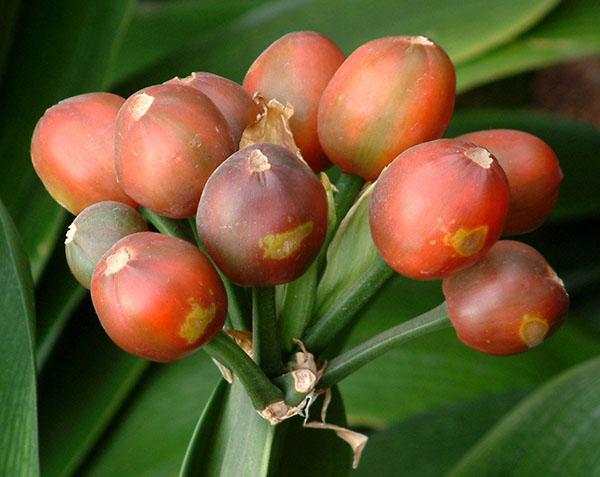Reproduction of clivia by seeds 4 years long
 A majestic tropical lily bush should decorate not only one place, but also be in every part of the house. Therefore, the propagation of clivia by seeds is carried out at the right time and in the right way. Nevertheless, the flower is often "duplicated" by the usual division of the bush. For painstaking and selfless gardeners, this method will seem boring. In this regard, they strive to breed seedlings in order to grow more than one seedling.
A majestic tropical lily bush should decorate not only one place, but also be in every part of the house. Therefore, the propagation of clivia by seeds is carried out at the right time and in the right way. Nevertheless, the flower is often "duplicated" by the usual division of the bush. For painstaking and selfless gardeners, this method will seem boring. In this regard, they strive to breed seedlings in order to grow more than one seedling.
Read also the article: clivia home care!
Reproduction of clivia is accompanied by more than one transplant
The seed ripening period lasts about 10 months. It begins with simple pollination and ends with the collection of planting material. Since each fruit contains many seeds, they are sown immediately after ripening, which is either November or April. They take as a land substrate:
- sand;
- turf;
- peat.
The first two mixtures are needed in a 1: 1 ratio, and the last one needs only 0.5 parts. The container is filled with mixed soil. The seeds are laid out in 2 cm increments and the container is covered. Be sure to ventilate daily for 15 minutes. Then after 6 weeks, when one independent leaf hatches, the seedlings are transplanted into pots (diameter 7 cm).
After transplanting the culture, it will take another six months until 4-5 beautiful leaves appear.
At this stage of reproduction, clivia is reduced to regular watering: 1-2 times a week. In this case, it is important not to rearrange or turn the flowerpot. As a result, after 2 years, the seedlings are transferred to larger tanks, somewhere around 9-10 cm in diameter. After 12 months, honey agarics are planning to be transplanted into 13-centimeter containers. But such a plant needs a different substrate:
- 2 tsp sod mixture;
- humus;
- peat;
- river sand.
The last components are taken in 1 part. Such a composition will help the culture grow productively. So, for a year, two pairs of young leaves are formed on the bush. For vallotta (another name for the variety), this is a quite expected increase.
It is important not to forget to make a drainage layer at the bottom in the form of broken brick, gravel or expanded clay.
Future life
In the third year, the plant goes into a dormant stage. In some cases, it is artificially created in September, while in the original it starts in November. Duration - two months. To ensure this state, it is important to stop watering the flowerpot and let the earth dry well, but so that the leaves do not fade. According to statistics, 30% of seedlings throw out peduncles after such care.
In cases where the culture has not bloomed, it continues to be kept in the same conditions. Only then the temperature is lowered to 10-12 ° C in order to awaken the kidneys.
When the top of the peduncle stem appears, the flowerpot is transferred to a warm room (18-20 ° C). During this period, the bush is abundantly watered and sprayed. At this stage, the reproduction of clivia ends, but it requires further painstaking care.